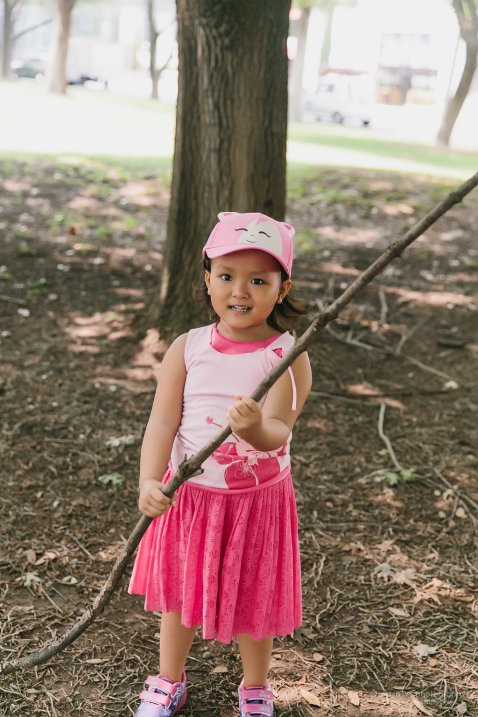We’ve been back from Monterrey for a day, and there’s so much to reflect on from this trip.
Unlike last summer, where we went with a clear vision and a plan—we were there to meet 11 families who’d brought their children to Mexico in search of a cure for DIPG and publish their stories to raise DIPG awareness and have people fall in love with these children, to show them that it truly could be anyone’s child affected, and we’re all responsible to help—this year, I just knew I needed to go back. I wanted to visit the families I already knew and love, and meet some that I hadn’t yet. I wanted to see how everyone was doing. It was time for an update.
Also unlike my previous visits, we didn’t stay with family. Kira lived another seven months with the treatment in Monterrey, but she passed away last November. So going back in that sense—since November was the last time I saw her alive, the last time I could hold her hand and tell her I love her and show her where she’d always stay, right here in my heart—was difficult.
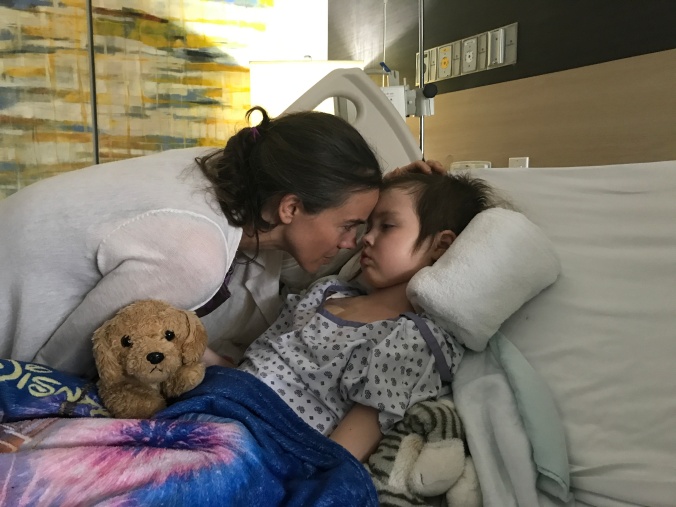
Kira and her mama, 11/17

The sweetest hand I’ve ever held
November was also the last time I saw Annabelle before she slipped into a coma. Her mum brought us homemade treats, and her dad drove me all over the city to gather medicine for Kira and the necessary paperwork for her to return home to Norway. Annabelle ran around the apartment and played out on the balcony, blowing bubbles with Kira’s little brother, and she recognized her wristband on my arm, pointing to it and saying her name.

Annabelle, 11/17
This time, Annabelle was attached to life support, as she continues to fight to come out of the coma that’s kept her sleeping for almost two months. Her parents take turns by her bedside, all the while caring for and trying to keep up with her 3-year-old sister, Alyssa. Yes, things have changed.
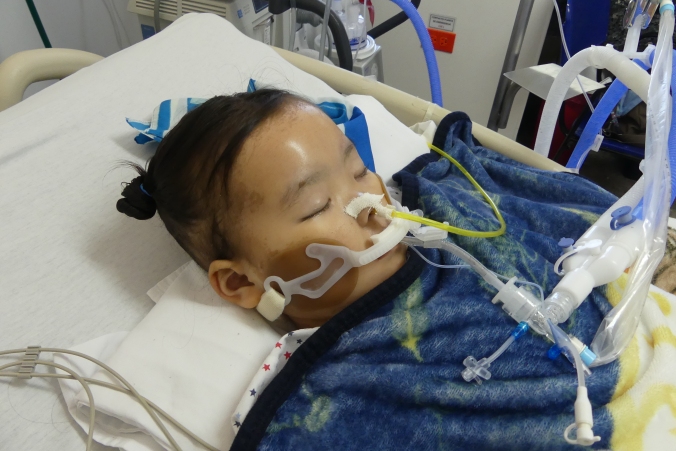
Annabelle, 6/18
They’ve also changed for little Edie, who arrived in Monterrey in early January in good clinical condition, and who worsened after each of her 5 treatments. She’s since made a comeback, though, with the help of a different set of medications tailored just for her, which target her tumor and have helped her regain the weight she’d lost and the strength and spunk that have always been a part of her, but laid dormant for some months. Her parents are currently investigating other treatments to help Edie continue on this healing path.

Edie, 6/18
And then there’s Zoé, who we met last year and who is still well, considering the beast she’s battling. Zoé’s speech has gotten a little less clear, and her walking more wobbly, but she continues to show DIPG who’s boss after fighting for over two years—a remarkable feat in itself.

Zoé, 6/18
And Kira, a girl who reminds me so much of our family’s Kira (I have to insert here that her mama always clarified that yes, she is her OWN Kira; no one could ever claim her as “theirs”), not only for her name, but also for her sweet ferocity. Kira is positively thriving, and her family credits the treatment for her well being.
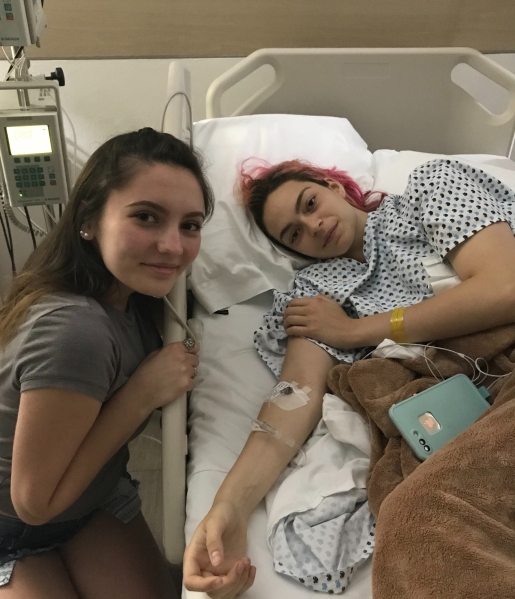
Kira with my daughter, Lily, 6/18
There were more children that I met and who I won’t include publicly. Some of them have declined over time and are fighting for their lives; others are responding to treatment and steadily improving; and others are in between—struggling intermittently and actively fighting.
I think it bears repeating here that none of the families were promised a cure in Monterrey, though of course we all pray that there will be a first to survive this monster.
My role in this project also bears repeating: I came to support the families who went to Mexico with their children, and with no attachment to this particular treatment. Rather, I came to help spread the love for these families and celebrate and foster the collective hope they found in and among each other as a community of transplants who went to the ends of the earth to try to save their children. My family was among them, and Kira my original inspiration. Now they are all family.
Beyond anything else, I think the most critical thing I learned, again, is the importance of showing every family living with this horrific diagnosis our enduring, unconditional support. There is no known cure for DIPG. Each family is doing their absolute best for their children who they love more than life. They go into this—and all decisions about their children’s care—with eyes wide open to all available information. They’ve thought long and hard about the best options for their children. They’re painfully aware that there is no right answer, no guarantee, nothing that has been proven to help. They are in a desperate, impossible position. For many, part of the process includes taking chances and leaps of faith and putting their children in experimental treatments (actually, every DIPG treatment is currently experimental), as they try to find anything that might save them.
It’s impossible for anyone who’s not been through the horror of DIPG to say what they would do at any point along the way. All of the decisions belong uniquely to each family; there is no right or wrong, no room for judgment, only for compassion.
Since this trip opened my eyes to even more of the hardships that these families face and the ever changing paths that many of them pursue, I’ve decided to spend more time exploring and learning about some of those options, and I hope to eventually include the stories of more children and families searching for a cure for DIPG, wherever their journeys might lead them. I hope you’ll join me as we continue to love and support each family, whatever path they choose for their child.
Thank you for being there.
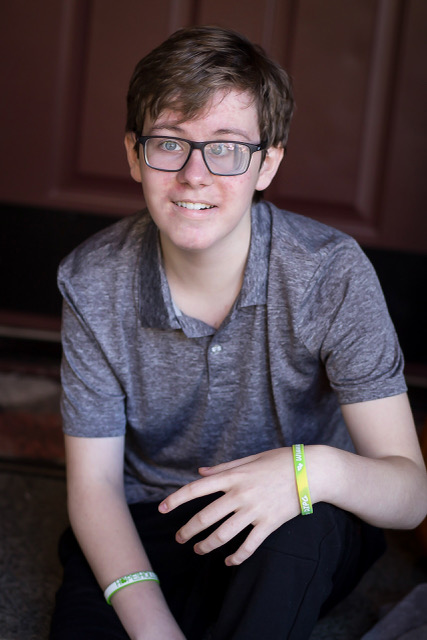 Two years ago today, on December 22nd, 2015, 15-year-old Camron Cozzi and his family received life-altering news: Camron had an inoperable brainstem tumor called DIPG.
Two years ago today, on December 22nd, 2015, 15-year-old Camron Cozzi and his family received life-altering news: Camron had an inoperable brainstem tumor called DIPG. Cam is the first child I’ve written about here who I haven’t met in person. We just missed him last summer when we went to Mexico to get to know 11 other DIPG fighters. I got closer in November, when we were 20 feet from each other, separated by the door to his room at Hospital Angeles. My cousin’s daughter, Kira, had been admitted to the same hospital when I ran into Camron’s father, Paul. He asked if I’d like to say hi to Cam. Under the circumstances and knowing that I couldn’t be fully present given what was going on with my family, I declined.
Cam is the first child I’ve written about here who I haven’t met in person. We just missed him last summer when we went to Mexico to get to know 11 other DIPG fighters. I got closer in November, when we were 20 feet from each other, separated by the door to his room at Hospital Angeles. My cousin’s daughter, Kira, had been admitted to the same hospital when I ran into Camron’s father, Paul. He asked if I’d like to say hi to Cam. Under the circumstances and knowing that I couldn’t be fully present given what was going on with my family, I declined.





 However, in October of 2016, Cam started to struggle walking and an MRI showed he was in progression. One week before Thanksgiving, he had a shunt installed to help relieve symptoms related to hydrocephalus (fluid buildup in the ventricles due to tumor growth, which increases pressure in the brain). Up until he had the shunt surgery, Cam attended school.
However, in October of 2016, Cam started to struggle walking and an MRI showed he was in progression. One week before Thanksgiving, he had a shunt installed to help relieve symptoms related to hydrocephalus (fluid buildup in the ventricles due to tumor growth, which increases pressure in the brain). Up until he had the shunt surgery, Cam attended school. Fortunately, Camron’s mother works from home as a photographer and graphic artist, enabling her to incorporate Camron’s care into her days. His dad also has some flexibility to work from home, so between them, they can make sure that Cam’s never home alone.
Fortunately, Camron’s mother works from home as a photographer and graphic artist, enabling her to incorporate Camron’s care into her days. His dad also has some flexibility to work from home, so between them, they can make sure that Cam’s never home alone. We would have wished it another way for you, Cam. But we stand with you now and maintain the faith that you will beat this cancer for good.
We would have wished it another way for you, Cam. But we stand with you now and maintain the faith that you will beat this cancer for good. We met with Zoé our last evening in Monterrey. Her family had just moved into their new apartment, where Zoé was quick to absorb my daughter Lily into her inner circle, cuddling her, presenting her with a handmade gift, working together on a puzzle, and watching one of Zoé’s favorite Disney movies (in French!). Her mother Emilie pretended to have her feelings hurt that Zoé allowed Lily to play with her, which delighted Zoé to no end.
We met with Zoé our last evening in Monterrey. Her family had just moved into their new apartment, where Zoé was quick to absorb my daughter Lily into her inner circle, cuddling her, presenting her with a handmade gift, working together on a puzzle, and watching one of Zoé’s favorite Disney movies (in French!). Her mother Emilie pretended to have her feelings hurt that Zoé allowed Lily to play with her, which delighted Zoé to no end. Emilie describes her own experience taking Zoé’s picture. When Emilie requested her to smile for the camera, Zoé asked, “Is there a school that can teach me how to smile?” Since the tumor developed, her brain seemed to have forgotten how to smile on command. But once Zoé starts laughing, her face can’t help but remember how to smile.
Emilie describes her own experience taking Zoé’s picture. When Emilie requested her to smile for the camera, Zoé asked, “Is there a school that can teach me how to smile?” Since the tumor developed, her brain seemed to have forgotten how to smile on command. But once Zoé starts laughing, her face can’t help but remember how to smile. As a result of her tumor, Zoé walks with a dainty tiptoe gait, which adds to her princess-like demeanor. DIPG has also caused Zoé to lose some of her characteristic self-confidence. She used to sing along to her favorite soundtracks, but gradually learned to doubt her ability when her voice didn’t respond as usual, and she fell silent. These subtle changes must be among the hardest—to count each subtraction that the disease makes from your child.
As a result of her tumor, Zoé walks with a dainty tiptoe gait, which adds to her princess-like demeanor. DIPG has also caused Zoé to lose some of her characteristic self-confidence. She used to sing along to her favorite soundtracks, but gradually learned to doubt her ability when her voice didn’t respond as usual, and she fell silent. These subtle changes must be among the hardest—to count each subtraction that the disease makes from your child. Every child with DIPG presents a bit differently, and Zoé is no exception. She’d had a bout of the flu, and subsequently developed a squint in her eye in the mornings that disappeared each day by around noon. Concerned but not overly alarmed, her parents took her to several ophthalmologists and eye specialists over the course of two months, who all confirmed that Zoé’s eyes were healthy and her vision was fine. But as the squint persisted, so did Zoé’s parents. They scheduled an MRI of her brain, and three days before the test, Zoé started having headaches located at the base of her skull. Emilie also describes a “far away look” to Zoé around that time.
Every child with DIPG presents a bit differently, and Zoé is no exception. She’d had a bout of the flu, and subsequently developed a squint in her eye in the mornings that disappeared each day by around noon. Concerned but not overly alarmed, her parents took her to several ophthalmologists and eye specialists over the course of two months, who all confirmed that Zoé’s eyes were healthy and her vision was fine. But as the squint persisted, so did Zoé’s parents. They scheduled an MRI of her brain, and three days before the test, Zoé started having headaches located at the base of her skull. Emilie also describes a “far away look” to Zoé around that time. After two rounds of radiation and inevitable progression on the horizon, Emilie and Sylvain considered taking Zoé to Cologne for immunotherapy. In the meantime, the buzz about Mexico started circulating widely among DIPG families via social media.
After two rounds of radiation and inevitable progression on the horizon, Emilie and Sylvain considered taking Zoé to Cologne for immunotherapy. In the meantime, the buzz about Mexico started circulating widely among DIPG families via social media. So far, the results of her treatments have been encouraging. Zoé’s speech and coordination have improved, she’s able to use the loo without Emilie’s assistance, her anxiety has lessened, and she’s more lively and energetic. She’s also started singing again. It’s hard to say for sure if the treatment in Mexico has led to these changes, if they’re residual from her last radiation sessions, or if it’s some combination of these.
So far, the results of her treatments have been encouraging. Zoé’s speech and coordination have improved, she’s able to use the loo without Emilie’s assistance, her anxiety has lessened, and she’s more lively and energetic. She’s also started singing again. It’s hard to say for sure if the treatment in Mexico has led to these changes, if they’re residual from her last radiation sessions, or if it’s some combination of these. Alan and his mom Midy and tia Michele were staying on the outskirts of central Monterrey. We met them the afternoon of the last full day of our trip in their new construction apartment, which Mariana Gutierrez—who Midy calls “Alan’s angel”—helped find them at a discounted rate for the week. Alan sat next to us on the couch taking in the conversation quietly, obviously missing nothing.
Alan and his mom Midy and tia Michele were staying on the outskirts of central Monterrey. We met them the afternoon of the last full day of our trip in their new construction apartment, which Mariana Gutierrez—who Midy calls “Alan’s angel”—helped find them at a discounted rate for the week. Alan sat next to us on the couch taking in the conversation quietly, obviously missing nothing. Midy admits they don’t talk about Alan’s tumor a lot, but when they do, they refer to it as a “little ball” on his brain. He knows he’s getting treatment for it, and he’s not immune to other kids’ reactions to his noticeable limp.
Midy admits they don’t talk about Alan’s tumor a lot, but when they do, they refer to it as a “little ball” on his brain. He knows he’s getting treatment for it, and he’s not immune to other kids’ reactions to his noticeable limp. Alan’s limp is what originally brought him to the doctor. An avid baseball player (“the fastest runner on my team”), Midy assumed that Alan had a sports injury. But when the orthopedist couldn’t find anything wrong, and Alan’s symptoms worsened to include headaches and the weakness affected his whole left side, they got an MRI. Alan was diagnosed with DIPG on February 17, 2017, and was scheduled to start radiation just one month before his 8th birthday.
Alan’s limp is what originally brought him to the doctor. An avid baseball player (“the fastest runner on my team”), Midy assumed that Alan had a sports injury. But when the orthopedist couldn’t find anything wrong, and Alan’s symptoms worsened to include headaches and the weakness affected his whole left side, they got an MRI. Alan was diagnosed with DIPG on February 17, 2017, and was scheduled to start radiation just one month before his 8th birthday.
 Alan shares the same number as his favorite baseball player, David Ortiz—Big Papi, who’s from the Dominican Republic like Midy’s family. Since we first learned about Alan, we’ve followed his journey on Facebook, and my daughter Lily’s had a special place in her heart for him. The best way she could think to describe her joy in finally meeting Alan in person was to explain that it would be like him getting to meet Big Papi. Now that he could relate to. Alan and Lily became fast friends, made closer since we left and they’ve been texting each other regularly.
Alan shares the same number as his favorite baseball player, David Ortiz—Big Papi, who’s from the Dominican Republic like Midy’s family. Since we first learned about Alan, we’ve followed his journey on Facebook, and my daughter Lily’s had a special place in her heart for him. The best way she could think to describe her joy in finally meeting Alan in person was to explain that it would be like him getting to meet Big Papi. Now that he could relate to. Alan and Lily became fast friends, made closer since we left and they’ve been texting each other regularly.

 “So many times I wish people could meet the “before DIPG” Julianna. She was always bubbling over with joy, happiness, and giggles. She had bouncing blonde curls and an infectious smile,” Julianna’s mom Stacie says.
“So many times I wish people could meet the “before DIPG” Julianna. She was always bubbling over with joy, happiness, and giggles. She had bouncing blonde curls and an infectious smile,” Julianna’s mom Stacie says. But she’s still in there, the child that everyone who knows her loves, telling us through half-opened mouth from her carefully positioned place in the corner of the couch all about her life in Walla Walla, Washington.
But she’s still in there, the child that everyone who knows her loves, telling us through half-opened mouth from her carefully positioned place in the corner of the couch all about her life in Walla Walla, Washington. Julianna has always led an active life surrounded by her family, who she adores. She is homeschooled, alongside 13-year-old brother Joshua and 7-year-old sister Jillian. She looks forward to learning in school every day, and she enjoys doing gymnastics, swimming, riding bikes, and playing soccer on a team every fall. As Julianna puts it, “I’m a going girl, not a sitting girl!”
Julianna has always led an active life surrounded by her family, who she adores. She is homeschooled, alongside 13-year-old brother Joshua and 7-year-old sister Jillian. She looks forward to learning in school every day, and she enjoys doing gymnastics, swimming, riding bikes, and playing soccer on a team every fall. As Julianna puts it, “I’m a going girl, not a sitting girl!” Stacie can’t help but well up at her daughter’s selfless desire to share her experience. She brushes away the tears that won’t listen as she shows us YouTube videos that Julianna made since her diagnosis, where she relates the depressing statistics about brain tumors. Julianna uses powerful graphics to show the disproportionate amount of funding that goes to adult cancers, as her own face is puffy from the steroids she takes to keep the swelling in her brain from her tumor under control.
Stacie can’t help but well up at her daughter’s selfless desire to share her experience. She brushes away the tears that won’t listen as she shows us YouTube videos that Julianna made since her diagnosis, where she relates the depressing statistics about brain tumors. Julianna uses powerful graphics to show the disproportionate amount of funding that goes to adult cancers, as her own face is puffy from the steroids she takes to keep the swelling in her brain from her tumor under control. The degree to which Julianna’s right eye turned in has only gotten worse over time, creating two images of everything she sees: a clear one, and one she knows isn’t real. As so often happens with cancer, the interventions and treatments have created their own set of problems. After the biopsy, the right side of Julianna’s face became paralyzed, and the left side of her body went numb. Radiation triggered temporary deafness in her right ear, and the CED infusions caused her to lose the use of her left hand and her left leg to become weak.
The degree to which Julianna’s right eye turned in has only gotten worse over time, creating two images of everything she sees: a clear one, and one she knows isn’t real. As so often happens with cancer, the interventions and treatments have created their own set of problems. After the biopsy, the right side of Julianna’s face became paralyzed, and the left side of her body went numb. Radiation triggered temporary deafness in her right ear, and the CED infusions caused her to lose the use of her left hand and her left leg to become weak. Even in Mexico with this promising treatment, Julianna has had a rocky road with her “bump.” The dizziness she experienced prior to her first IA subsided initially after treatment, but has since returned. She also developed some shakiness in her hands that worsened after her second IA. They had to increase her steroid dose yet again because of inflammation, which has pushed out the start date for immunotherapy.
Even in Mexico with this promising treatment, Julianna has had a rocky road with her “bump.” The dizziness she experienced prior to her first IA subsided initially after treatment, but has since returned. She also developed some shakiness in her hands that worsened after her second IA. They had to increase her steroid dose yet again because of inflammation, which has pushed out the start date for immunotherapy. That night, Julianna also decided to start a foundation that would help other children battling DIPG. Whenever anyone gives her spending money, Julianna puts it straight into her project fund. “She loves to count it and talk about how she wants to tell her story to raise awareness and be other kids’ hope after she gets well,” says Stacie.
That night, Julianna also decided to start a foundation that would help other children battling DIPG. Whenever anyone gives her spending money, Julianna puts it straight into her project fund. “She loves to count it and talk about how she wants to tell her story to raise awareness and be other kids’ hope after she gets well,” says Stacie.



 Splashing around in the water with his siblings at all is a huge accomplishment, considering where Luke was a couple of months ago. Lewis couldn’t understand why his brother wasn’t answering his requests to play or even talk with him, and Jenny described Luke as looking glassy-eyed and unresponsive. He was declining rapidly, and hope seemed far off.
Splashing around in the water with his siblings at all is a huge accomplishment, considering where Luke was a couple of months ago. Lewis couldn’t understand why his brother wasn’t answering his requests to play or even talk with him, and Jenny described Luke as looking glassy-eyed and unresponsive. He was declining rapidly, and hope seemed far off. Jenny and Mark take Luke’s illness in stride with everything else thrown their way. They treat Luke the same as his siblings, and don’t panic over little setbacks, maintaining some much-needed normalcy in all of their lives. But don’t interpret that as a sign of their giving up: Jenny maintains a perpetual presence on social media, regularly posting pictures and updating Luke’s faithful followers on his progress, and she hunts down every available treatment option for her son. She’s an untiring, fearless constant in his life, aiming to ensure he has the best chance at beating this disease. “I wouldn’t be a mother if I didn’t do everything in my power,” Jenny says. “I’ll never give up trying to save him.”
Jenny and Mark take Luke’s illness in stride with everything else thrown their way. They treat Luke the same as his siblings, and don’t panic over little setbacks, maintaining some much-needed normalcy in all of their lives. But don’t interpret that as a sign of their giving up: Jenny maintains a perpetual presence on social media, regularly posting pictures and updating Luke’s faithful followers on his progress, and she hunts down every available treatment option for her son. She’s an untiring, fearless constant in his life, aiming to ensure he has the best chance at beating this disease. “I wouldn’t be a mother if I didn’t do everything in my power,” Jenny says. “I’ll never give up trying to save him.”

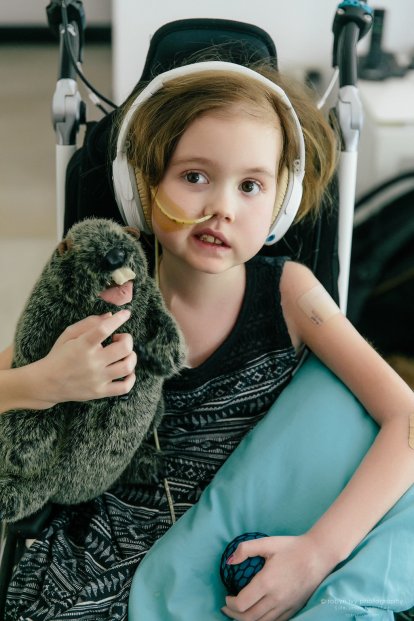 The first time I met Kira in person, she was visiting Rhode Island with her family—her Mama (my cousin, Jeni) and Pappa (Trond), and Kira’s brothers, August and Jasper.
The first time I met Kira in person, she was visiting Rhode Island with her family—her Mama (my cousin, Jeni) and Pappa (Trond), and Kira’s brothers, August and Jasper.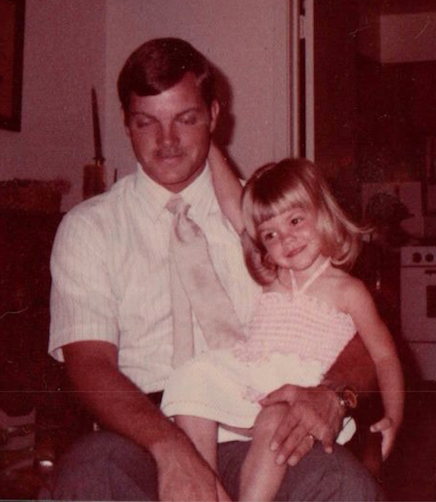 She never let anyone help her cross the street, insisting she could hold her own hand.
She never let anyone help her cross the street, insisting she could hold her own hand.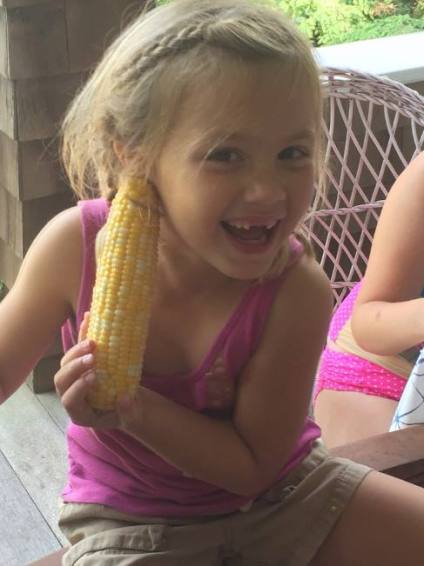 She splashed her way through the fountains in Boston Commons and chatted with strangers on the T, informing them that she used to live in Bolivia and was moving to Ghana next. And she got temporarily separated from us as we exited the station.
She splashed her way through the fountains in Boston Commons and chatted with strangers on the T, informing them that she used to live in Bolivia and was moving to Ghana next. And she got temporarily separated from us as we exited the station.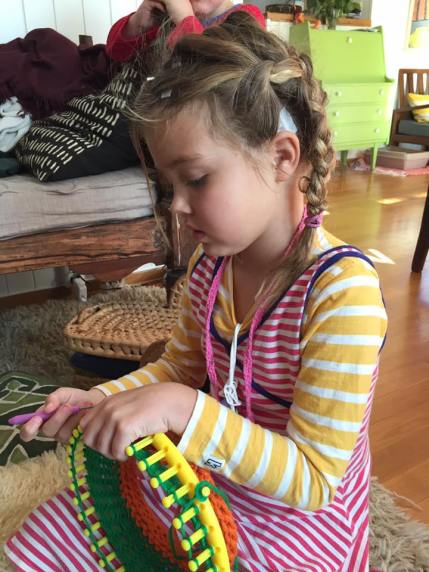 She had a brief “honeymoon period” after radiation, when her grandparents from Norway and Texas came to spend some time with Kira and the family. They picnicked near the fjords, went ice-skating, and made Kira’s favorite meal of sushi together.
She had a brief “honeymoon period” after radiation, when her grandparents from Norway and Texas came to spend some time with Kira and the family. They picnicked near the fjords, went ice-skating, and made Kira’s favorite meal of sushi together.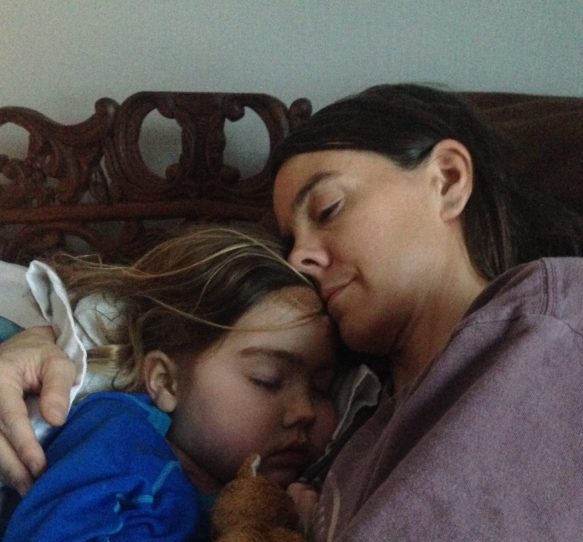 Then somehow, in this darkest hour, miraculously, Kira started very gradually regaining some of the functions she’d lost. She began to use her right hand again to form a half heart, made whole by Jeni, to tell her Mama she loved her. Over time, she started speaking a few words, and not long after, Kira was able to sit up and eat a couple bites of food, even joining the family at the table for Easter dinner.
Then somehow, in this darkest hour, miraculously, Kira started very gradually regaining some of the functions she’d lost. She began to use her right hand again to form a half heart, made whole by Jeni, to tell her Mama she loved her. Over time, she started speaking a few words, and not long after, Kira was able to sit up and eat a couple bites of food, even joining the family at the table for Easter dinner.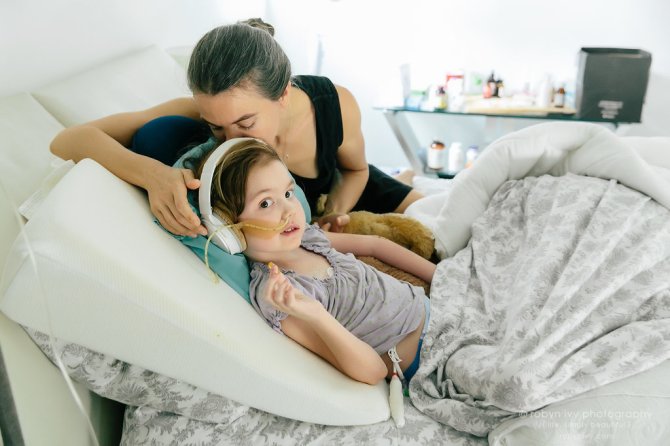 I went to Mexico in May when Jeni’s dad, who’d been down there helping them since they arrived, needed to return home to Texas for a few days. Even after my mother and my aunts had told me about their recent visits with Kira and I’d seen her pictures for months, nothing could have prepared me for the child who met me when I arrived.
I went to Mexico in May when Jeni’s dad, who’d been down there helping them since they arrived, needed to return home to Texas for a few days. Even after my mother and my aunts had told me about their recent visits with Kira and I’d seen her pictures for months, nothing could have prepared me for the child who met me when I arrived.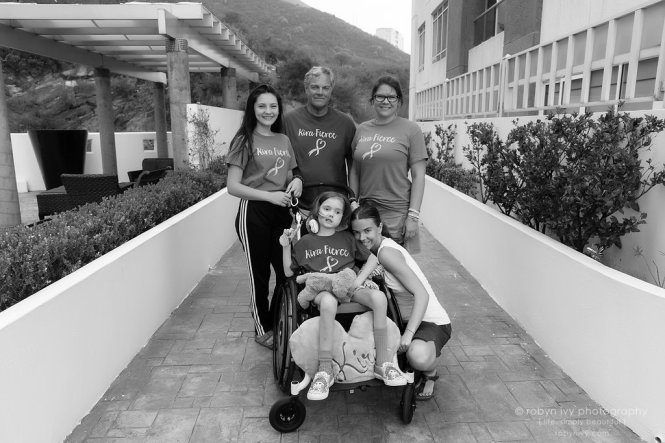 The next time, I came with Kira’s cousin, Lily. Though they’d not seen each other in nearly two years, the bond they shared retied itself as they fell back into their easy, comfortable closeness. Kira brushed Lily’s hair, told her she loved her (something normally reserved for Mama and Pappa), and pulled her close to whisper in her ear to please stop blowing kisses. “I don’t like kisses at all.”
The next time, I came with Kira’s cousin, Lily. Though they’d not seen each other in nearly two years, the bond they shared retied itself as they fell back into their easy, comfortable closeness. Kira brushed Lily’s hair, told her she loved her (something normally reserved for Mama and Pappa), and pulled her close to whisper in her ear to please stop blowing kisses. “I don’t like kisses at all.”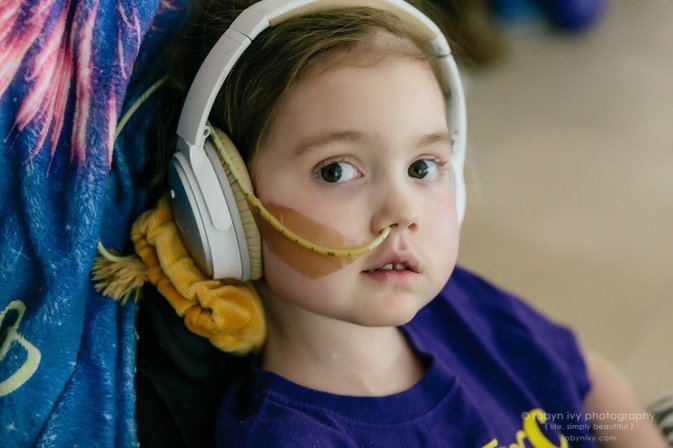 Kira’s now had five IA treatments. With each one, she gains a little more functioning. She can move her left arm and pull herself up to standing with assistance, her speech is becoming clearer and stronger, and her once broad vocabulary is returning.
Kira’s now had five IA treatments. With each one, she gains a little more functioning. She can move her left arm and pull herself up to standing with assistance, her speech is becoming clearer and stronger, and her once broad vocabulary is returning.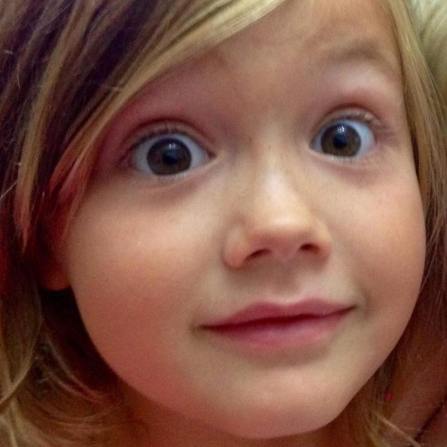
 If “pink” could name someone’s personality, surely it would be Kaleigh’s. With her sights set on someday becoming a princess, Kaleigh gets in lots of practice for her future position. She’s straightforward, yet gracious; determined, but considerate.
If “pink” could name someone’s personality, surely it would be Kaleigh’s. With her sights set on someday becoming a princess, Kaleigh gets in lots of practice for her future position. She’s straightforward, yet gracious; determined, but considerate.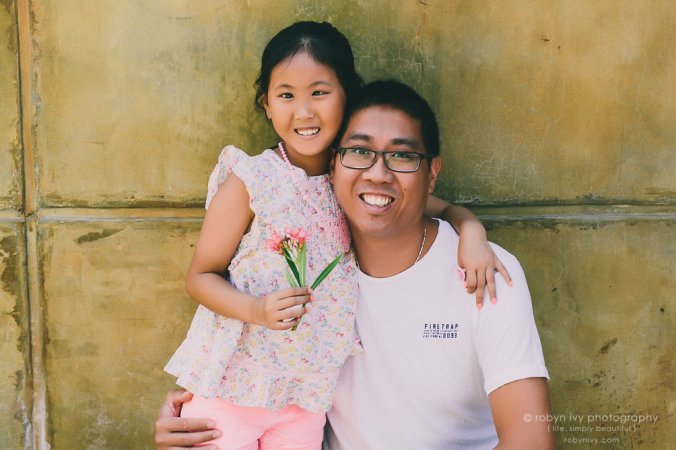 Apart from an inturned eye, Kaleigh appears completely healthy and vital. But not too long ago, her tumor was in progression.
Apart from an inturned eye, Kaleigh appears completely healthy and vital. But not too long ago, her tumor was in progression. Kaleigh started radiotherapy on April 25th, 2016. She completed 30 sessions, followed by a long 7-month “honeymoon” period, after which her double vision returned. She underwent 10 more radiotherapy sessions starting in January of 2017, but her vision problems persisted, and some new symptoms started: her left hand got weaker, she began to stutter, her walking became unbalanced, and she developed regular headaches.
Kaleigh started radiotherapy on April 25th, 2016. She completed 30 sessions, followed by a long 7-month “honeymoon” period, after which her double vision returned. She underwent 10 more radiotherapy sessions starting in January of 2017, but her vision problems persisted, and some new symptoms started: her left hand got weaker, she began to stutter, her walking became unbalanced, and she developed regular headaches.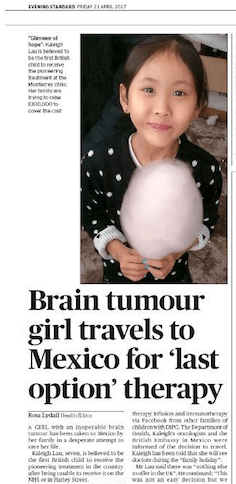 Kaleigh had her 5th IA and her 4th immunotherapy on July 3rd, after which they returned to London for a few weeks. Scott champions the treatment, crediting it for saving Kaleigh’s life, giving her back her personality, and helping her return to doing the things she loves, like the monkey bars. It’s not surprising that others have followed his lead and he’s become the Monterrey “cheerleader,” answering parents’ questions and helping connect families with local resources.
Kaleigh had her 5th IA and her 4th immunotherapy on July 3rd, after which they returned to London for a few weeks. Scott champions the treatment, crediting it for saving Kaleigh’s life, giving her back her personality, and helping her return to doing the things she loves, like the monkey bars. It’s not surprising that others have followed his lead and he’s become the Monterrey “cheerleader,” answering parents’ questions and helping connect families with local resources. Scott’s upbeat attitude is completely catching—he lives by his belief that happiness is the best medicine, which is why he insisted the whole family go to Mexico for Kaleigh’s treatments. His company has fortunately shown incredible support, allowing them to be together while Scott takes time off of work and Kaleigh continues to respond positively to this potentially life-saving therapy.
Scott’s upbeat attitude is completely catching—he lives by his belief that happiness is the best medicine, which is why he insisted the whole family go to Mexico for Kaleigh’s treatments. His company has fortunately shown incredible support, allowing them to be together while Scott takes time off of work and Kaleigh continues to respond positively to this potentially life-saving therapy. Between doctor’s appointments, blood draws, and treatments, they aim to enjoy their time there as if on holiday. They meet up with other families for swimming and to share meals, and Scott arranged for the families to attend the local Kidzania and Safari park at discounted price. This gives the families precious opportunity to connect with each other and fill up on encouragement that only people going through the same heartache can offer.
Between doctor’s appointments, blood draws, and treatments, they aim to enjoy their time there as if on holiday. They meet up with other families for swimming and to share meals, and Scott arranged for the families to attend the local Kidzania and Safari park at discounted price. This gives the families precious opportunity to connect with each other and fill up on encouragement that only people going through the same heartache can offer.

 Hunter went back to school half-days part way through radiation, and after he completed treatment on March 9th, the family decided to enjoy the “honeymoon period”—a brief time during which children often have few symptoms after radiation and before progression begins. They went to Arizona for a couple weeks to see Krista’s parents, where Hunter enjoyed swimming in the pool, and they visited the Grand Canyon and Sedona.
Hunter went back to school half-days part way through radiation, and after he completed treatment on March 9th, the family decided to enjoy the “honeymoon period”—a brief time during which children often have few symptoms after radiation and before progression begins. They went to Arizona for a couple weeks to see Krista’s parents, where Hunter enjoyed swimming in the pool, and they visited the Grand Canyon and Sedona. On their return from Hawaii, Krista contacted Mariana to schedule their trip to Monterrey in two weeks. However, “our universe cracked again” when Hunter—literally overnight—started having trouble swallowing, and the next day lost the use of his left side, and his speech became slow and slurred.
On their return from Hawaii, Krista contacted Mariana to schedule their trip to Monterrey in two weeks. However, “our universe cracked again” when Hunter—literally overnight—started having trouble swallowing, and the next day lost the use of his left side, and his speech became slow and slurred. Hunter has had his own roller coaster of emotions, too. Fear and anxiety loom over his appointments and procedures, and he’s cried a few times, asking why he has to be different and have this “bump in his brain.” But he’s amazingly resilient, never complaining or saying no. He just asks when his appointments are.
Hunter has had his own roller coaster of emotions, too. Fear and anxiety loom over his appointments and procedures, and he’s cried a few times, asking why he has to be different and have this “bump in his brain.” But he’s amazingly resilient, never complaining or saying no. He just asks when his appointments are.
 Now, instead of begging God to heal their child, they’re unraveling the answers to the question once asked of them.
Now, instead of begging God to heal their child, they’re unraveling the answers to the question once asked of them.
 Ronil’s story is one of the hardest for me to write, maybe because I so clearly remember being 13, but more likely because of how he lives his life—with devastating beauty.
Ronil’s story is one of the hardest for me to write, maybe because I so clearly remember being 13, but more likely because of how he lives his life—with devastating beauty.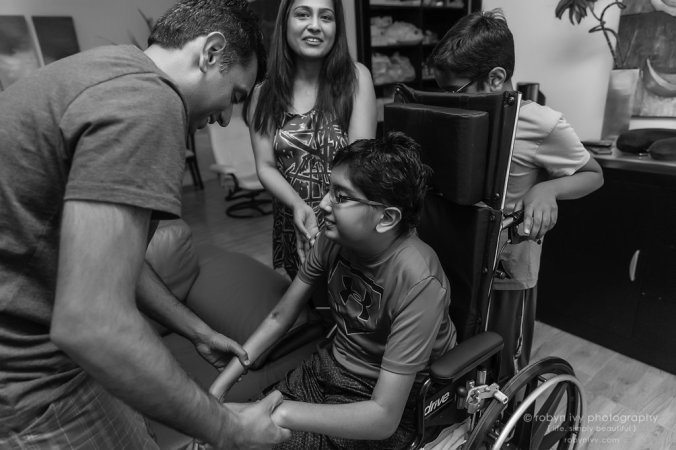 In January of 2016, Ronnie felt dizzy and collapsed unconscious on the floor while getting ready for school. An MRI showed he’d suffered two strokes due to a tumor in his brainstem. He fell into a coma, which he wasn’t expected to come out of. The doctors encouraged his parents Manisha and Milan to take Ronil off of life support, but they fought them, saying, “He will wake up.”
In January of 2016, Ronnie felt dizzy and collapsed unconscious on the floor while getting ready for school. An MRI showed he’d suffered two strokes due to a tumor in his brainstem. He fell into a coma, which he wasn’t expected to come out of. The doctors encouraged his parents Manisha and Milan to take Ronil off of life support, but they fought them, saying, “He will wake up.”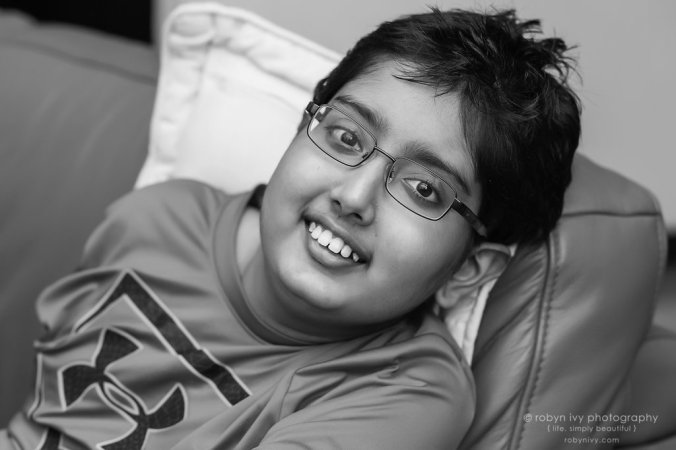 After the initial inflammation from radiation had settled by June, Ronnie was able to get around with a walker and eat by himself. He told his parents he wanted to walk, play basketball, and go to school again. His neuro-oncologist told his parents, “That’s not going to happen. He needs to aim lower.”
After the initial inflammation from radiation had settled by June, Ronnie was able to get around with a walker and eat by himself. He told his parents he wanted to walk, play basketball, and go to school again. His neuro-oncologist told his parents, “That’s not going to happen. He needs to aim lower.”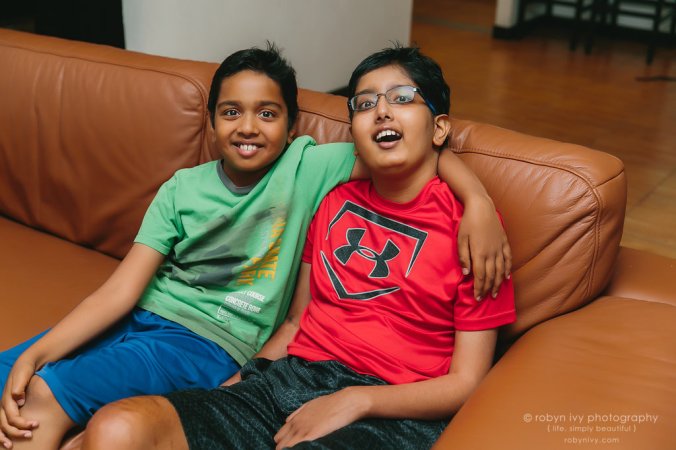 But in January of 2017, Ronnie started having trouble eating and walking, and a scan confirmed that he was in progression. He underwent emergency brain surgery to put in a shunt to treat hydrocephalus. Within the span of one week in February, he lost the ability to walk, stand, and talk. He completed 12 sessions of re-radiation at UCSF, and he also received immunotherapy, but these did little to restore his functions, as his tumor was still in progression.
But in January of 2017, Ronnie started having trouble eating and walking, and a scan confirmed that he was in progression. He underwent emergency brain surgery to put in a shunt to treat hydrocephalus. Within the span of one week in February, he lost the ability to walk, stand, and talk. He completed 12 sessions of re-radiation at UCSF, and he also received immunotherapy, but these did little to restore his functions, as his tumor was still in progression.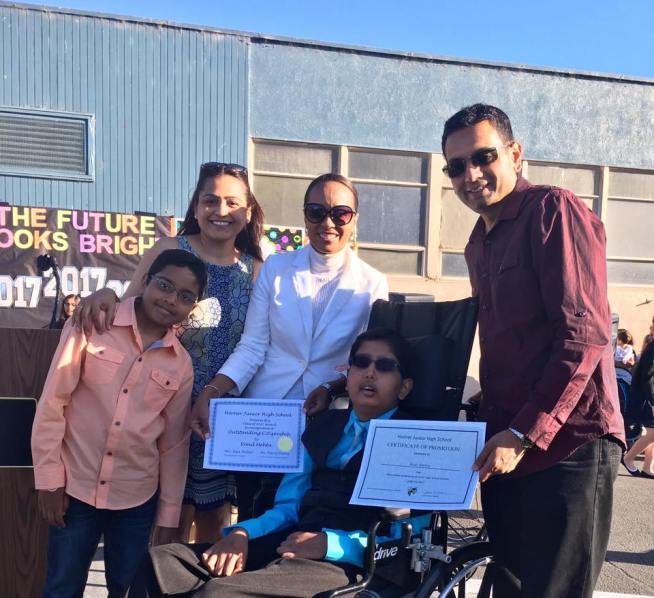 Ronnie’s 5th IA is scheduled for late July, after which they’ll go back home for a few weeks. In order to also receive the immunotherapy part of the treatment, Ronnie has to completely wean off of steroids. Manisha fears she may have moved too quickly when reducing his dose, as Ronnie lost the use of his right hand—one of the few things he could control—after coming off steroids. She weeps as she explains that even as she increased his dose again, he still can’t use that hand. The guilt she feels is suffocating.
Ronnie’s 5th IA is scheduled for late July, after which they’ll go back home for a few weeks. In order to also receive the immunotherapy part of the treatment, Ronnie has to completely wean off of steroids. Manisha fears she may have moved too quickly when reducing his dose, as Ronnie lost the use of his right hand—one of the few things he could control—after coming off steroids. She weeps as she explains that even as she increased his dose again, he still can’t use that hand. The guilt she feels is suffocating.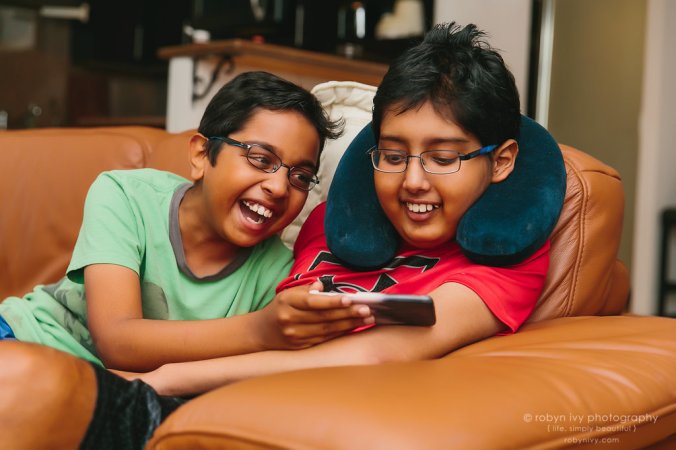 Ronil even inspired President Obama, who wrote him a personally signed letter from the White House where the president and first lady acknowledged his bravery and encouraged him to keep fighting.
Ronil even inspired President Obama, who wrote him a personally signed letter from the White House where the president and first lady acknowledged his bravery and encouraged him to keep fighting. Sadly, on September 1st, 2018–the first day of Childhood Cancer Awareness Month–Ronil passed away. Your legacy lives on in everyone you knew and touched, Ronnie.
Sadly, on September 1st, 2018–the first day of Childhood Cancer Awareness Month–Ronil passed away. Your legacy lives on in everyone you knew and touched, Ronnie.





